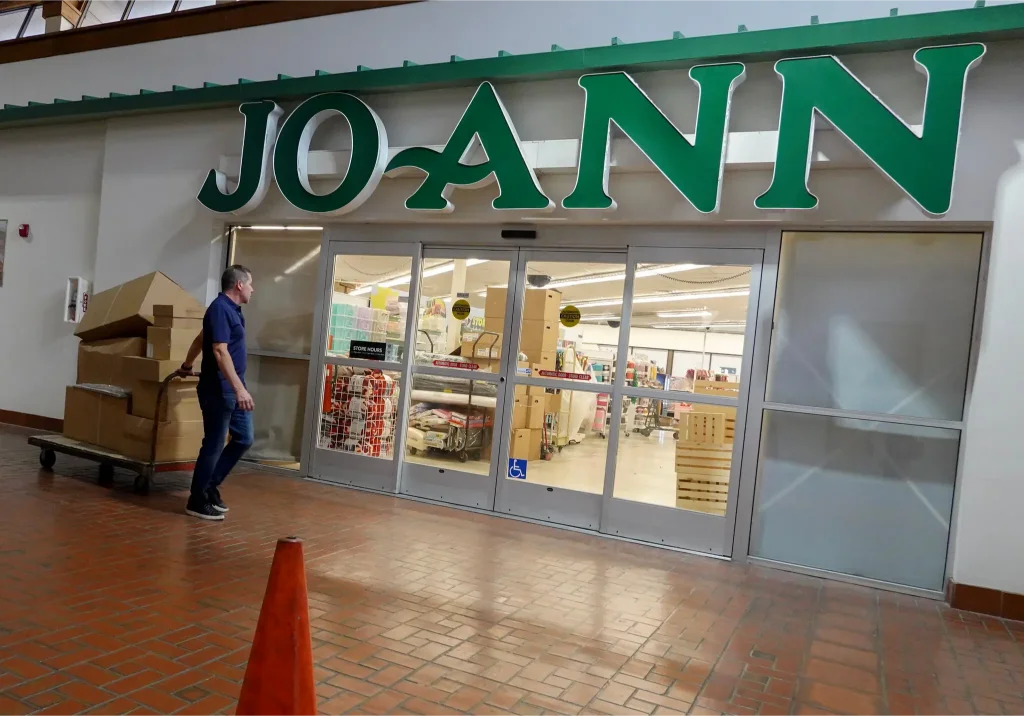The Fall of a Retail Giant: What Joann’s Closure Means for Retail Investment Strategy

After eight decades as a cornerstone of the American crafting industry, Joann has announced the closure of all its remaining stores. This development represents more than just the end of a familiar retail presence—it signals important shifts in the retail landscape that investors must understand. Let’s examine the implications of this closure and extract valuable investment insights.
The Final Chapter for an American Retail Institution
Joann, the 80-year-old fabrics and crafts retailer that grew into a nationwide presence with stores in 49 states, is closing all its locations following a bankruptcy auction. The winning bidder, GA Group, plans to liquidate the company’s assets through going-out-of-business sales—marking the end of a brand that supplied generations of quilters, seamstresses, and craft enthusiasts.
This closure comes after multiple attempts at financial restructuring, including two Chapter 11 bankruptcy filings within a year. Despite efforts to reduce debt and restructure operations, Joann couldn’t overcome what its leadership described as “significant and lasting challenges in the retail environment.”
Anatomy of a Retail Collapse: What Went Wrong
Joann’s downfall wasn’t sudden but rather the culmination of several critical factors that investors should recognize:
Market Positioning Challenges: Joann operated in a competitive space between e-commerce platforms offering convenience and big-box retailers providing lower prices. This middle-market position became increasingly difficult to defend.
Debt Structure: The company’s debt burden proved insurmountable, particularly as sales declined. The March 2023 bankruptcy filing aimed to reduce this debt, but the company couldn’t achieve sustainable financial footing.
Inventory Management: In its February announcement of store closures, Joann specifically cited “constrained inventory levels” as a contributing factor to its difficulties—a classic retail death spiral where diminishing cash flow prevents adequate stocking, further reducing customer traffic.
Digital Transformation Lag: While the company had an online presence, it failed to fully adapt to the digital-first approach that successful specialty retailers now require.
The Broader Retail Landscape: Warning Signs and Opportunities
Joann’s failure exists within a larger context of retail disruption that offers valuable signals for investors:
Specialty Retail Polarization: The market is increasingly rewarding two types of specialty retailers: premium experience-focused brands with strong customer loyalty, and value-oriented retailers with exceptional operational efficiency. Companies caught in the middle face compression from both sides.
Omnichannel Necessity: Retailers that have successfully integrated digital and physical presence show greater resilience. The seamless connection between online discovery and in-store experience has become essential rather than optional.
Customer Data Leverage: Retailers effectively utilizing customer data to personalize offerings and optimize inventory are demonstrating superior performance. This capability distinction is creating a widening gap between retail winners and losers.
Private Equity’s Role in Retail Restructuring
Joann’s journey illustrates important lessons about private equity involvement in retail:
The company went public in 2021 after being taken private by Leonard Green & Partners in 2011 for $1.6 billion. Following its first bankruptcy filing in 2023, it returned to private ownership. This cycle of ownership changes, combined with debt structures that limited operational flexibility, contributed to its inability to execute necessary transformations.
When evaluating retail investments, assessing the capital structure is as important as examining the consumer proposition. Even strong retail concepts can falter under excessive financial leverage that restricts their ability to invest in crucial digital capabilities and store experiences.
Digital Transformation: The Essential Survival Strategy
The craft and hobby market itself remains viable—estimated at over $40 billion annually in the U.S.—but the winners are those who have transformed their approach:
Community Building: Successful specialty retailers have shifted from pure product providers to community hubs, offering classes, events, and content that digital-only competitors cannot replicate.
Subscription Models: Introducing predictable revenue streams through subscription offerings has helped specialty retailers smooth cash flow and deepen customer relationships.
Marketplace Integration: Rather than fighting e-commerce platforms, strategic retailers are leveraging them as additional distribution channels while maintaining direct relationships with core customers.
The Future of Specialty Retail: Investment Considerations
For investors looking at retail opportunities in the wake of Joann’s closure, several factors merit close attention:
Supply Chain Agility: Retailers with adaptable supply chains that can quickly respond to trends and avoid excessive inventory show greater resilience.
Real Estate Strategy: Smart footprint management—often meaning smaller, more experience-focused stores in strategic locations—is increasingly separating successful specialty retailers from struggling ones.
Vertical Integration: Companies controlling more of their supply chain demonstrate better margin protection and inventory management, particularly in specialty categories.
Data Infrastructure: Investment in data capabilities is no longer optional for retailers—those using predictive analytics for inventory management and personalized marketing are showing superior performance.
Key Takeaways for Investors
Joann’s closure offers several crucial lessons for investment strategy in retail and beyond:
- Debt Matters: Excessive leverage can prevent otherwise viable businesses from making necessary strategic pivots.
- Middle-Market Squeeze: Companies positioned between premium and value offerings face increasing pressure and require exceptional execution to succeed.
- Digital Transformation Speed: The pace of digital adoption is as important as the adoption itself—companies that move too slowly risk permanent market share loss.
- Consumer Loyalty Drivers: Understanding what truly drives customer loyalty—product, experience, convenience, or community—is essential for evaluating retail sustainability.
- Acquisition Opportunities: The specialty retail landscape will likely see further consolidation, potentially creating selective opportunities to acquire customer bases, locations, or capabilities at attractive valuations.
As we witness the end of a retail institution like Joann, the most valuable perspective for investors is forward-looking: identifying which companies are successfully navigating similar challenges and positioning themselves for sustainable growth in a transformed retail environment.
Stay up to date!
Don’t miss out on valuable information we provide, Join our mailing list and stay up to date with weekly digest of exclusive contents that I don’t share anywhere else!
Join Atlantic Trading Community
Join the ever-growing trading community. A home where expert traders meet the power of technology to Analyse Stock Prices with AI to provide you Live Signals on the current market.



